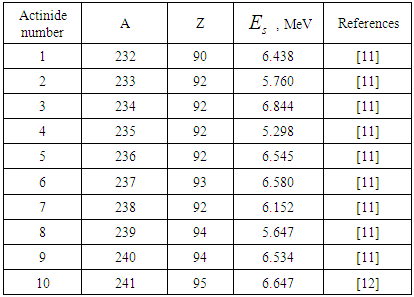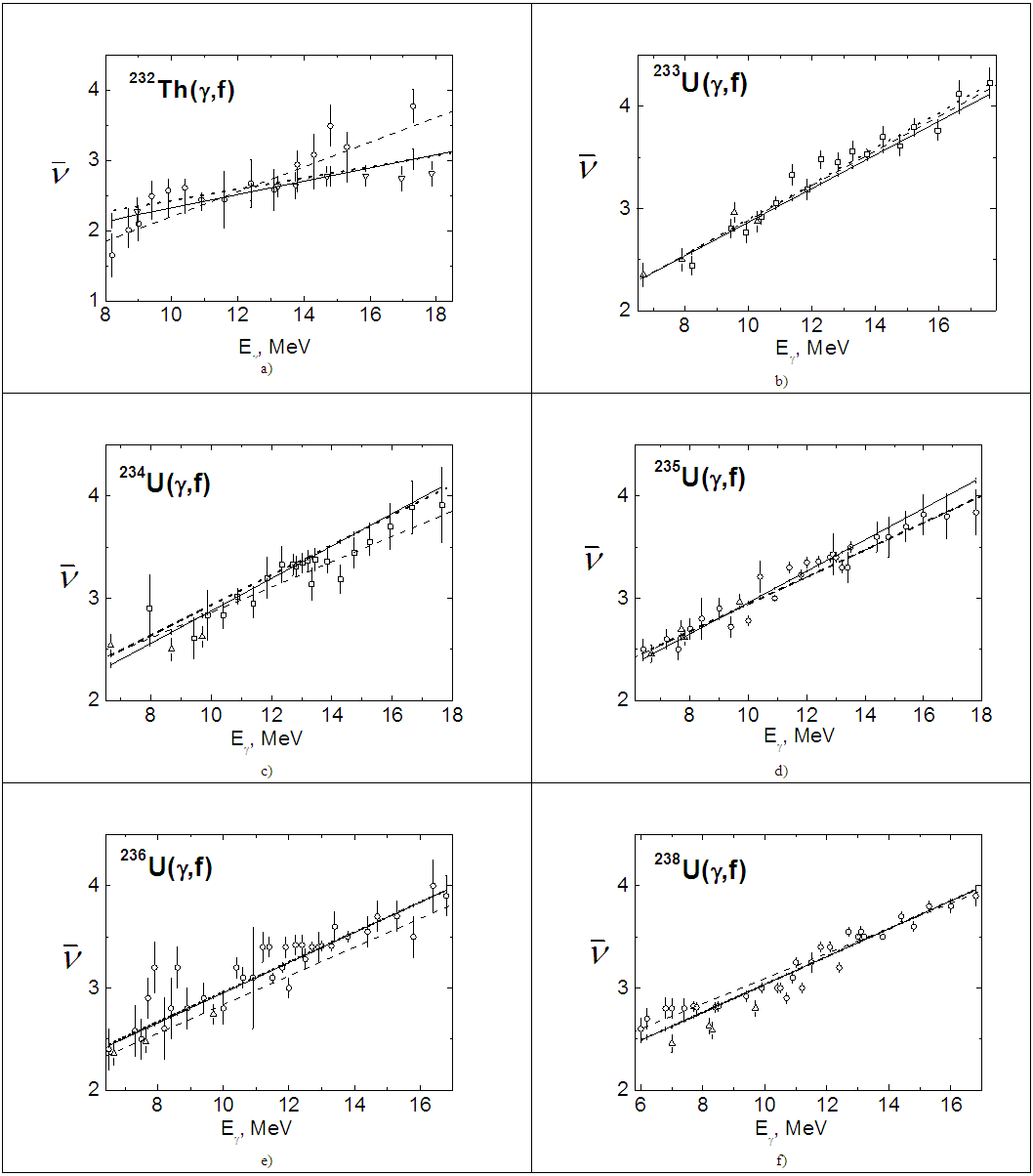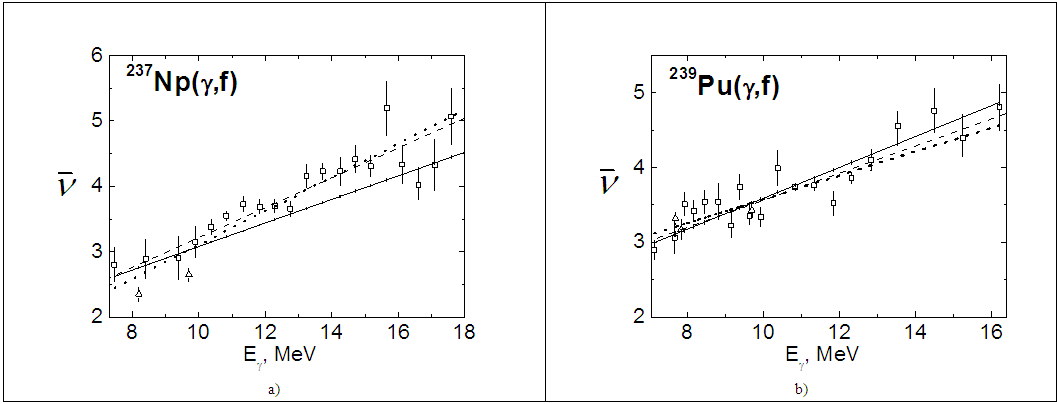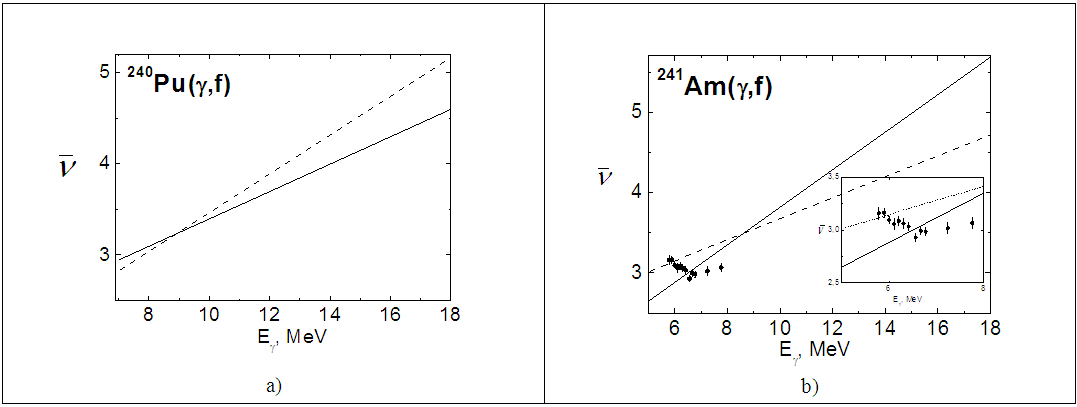A. I. Lengyel 1, O. O. Parlag 1, V. T. Maslyuk 1, M. I. Romanyuk 1, O. O. Gritzay 2
1Institute of Electron Physics, Universitetska 21, Uzhgorod, Ukraine
2Institute for Nuclear Research, Prospekt Nauky 47, Kiev, Ukraine
Correspondence to: M. I. Romanyuk , Institute of Electron Physics, Universitetska 21, Uzhgorod, Ukraine.
| Email: |  |
Copyright © 2016 Scientific & Academic Publishing. All Rights Reserved.
This work is licensed under the Creative Commons Attribution International License (CC BY).
http://creativecommons.org/licenses/by/4.0/

Abstract
The empirical calculations of the prompt neutrons average number  for photofission of the 232Th, 233U, 234U, 235U, 236U, 238U, 237Np, 239Pu and 241Am actinides has been done as a function of photon energy, mass and charge of the nuclei, which can be used to evaluate the
for photofission of the 232Th, 233U, 234U, 235U, 236U, 238U, 237Np, 239Pu and 241Am actinides has been done as a function of photon energy, mass and charge of the nuclei, which can be used to evaluate the  for photo-fission of nuclides for which no or scarce data are available.
for photo-fission of nuclides for which no or scarce data are available.
Keywords:
Average number of prompt neutrons, Photofission, Actinides
Cite this paper: A. I. Lengyel , O. O. Parlag , V. T. Maslyuk , M. I. Romanyuk , O. O. Gritzay , Calculations of Average Numbers of Prompt Neutrons for Actinide Photofission, Journal of Nuclear and Particle Physics, Vol. 6 No. 2, 2016, pp. 43-46. doi: 10.5923/j.jnpp.20160602.03.
1. Introduction
The average number of prompt neutrons is one of two (along with the fission cross section) major nuclear-physical parameters required for practical calculations. This value is determined in detail and accurately for neutron-induced reactions for the most nuclides. At the same time, the experimental data and evaluation of the average number of prompt neutrons in the case of photofission are much scarcer, old-fashioned or obtained by indirect mode [1, 2]. With the increasing interest in the methods of nuclear fuel burning and long-lived actinide decontamination the need in precise values of nuclear constants is evident during last years. This is especially true for photonuclear constants. Therefore, the search was focused on a formula that can be used to estimate the value of  for photofission of arbitrary actinide.
for photofission of arbitrary actinide.
2. General Approach
Let’s consider a general approach to modeling the average number of the prompt neutrons in the case of neutron activated fission. This value is a function of three variables: the mass of the compound nucleus A, its charge Z and the incident neutron energy  In previous studies [3-5] it has been shown that expanding the charge, mass and energy dependence of in the form of truncated Taylor series apparently yields a reasonable representation for
In previous studies [3-5] it has been shown that expanding the charge, mass and energy dependence of in the form of truncated Taylor series apparently yields a reasonable representation for  if the zero-, first- and one second-order cross term are kept in truncation for all isotopes, i. e. it is sufficient to use a linear approximation over all three variables, at least up to the threshold (γ,2nf), taking into account the contribution of the even-odd effect in a common form:
if the zero-, first- and one second-order cross term are kept in truncation for all isotopes, i. e. it is sufficient to use a linear approximation over all three variables, at least up to the threshold (γ,2nf), taking into account the contribution of the even-odd effect in a common form: | (1) |
where the intercept  | (2) |
and slope | (3) |
 | (4) |
Z0, A0 and E0 are the values, about which the expansion is to be made [3].The coefficients Ci in equations (1) – (3) were evaluated by the least-square method [5]. A wide range of existing data for  (A,Z,En) for actinides from 232Th to 245Cm was analyzed and the best simplified parameterization of the slope and intercept was recently found in [6]:
(A,Z,En) for actinides from 232Th to 245Cm was analyzed and the best simplified parameterization of the slope and intercept was recently found in [6]: | (5) |
 | (6) |
 | (7) |
These calculations were performed in the case of neutron-induced actinide fission without taking into account other reactions. Generally speaking, all mentioned approaches have to be versatile and suitable for all other cases of fission, including photofission. Therefore, we applied the model (1-4) in the case of photofission, where (En – E0) is replaced by (Еγ – Es), Еγ – photon energy, Es – nucleon separation energy. To do this, we take into account the wide experimental data set of photofission  (A,Z,Eγ) in the energy range ~ 8 – 20 MeV for actinides 232Th [7, 8], and ~ 5 – 20 MeV for 233U [9, 10], 234U [9, 10], 235U [7, 9], 236U [7, 9], 238U [7, 9], 237Np [9, 10] and 239Pu [9, 10]. We used all these 219 experimental points for our calculation.The values of the nucleon separation energy for each actinide were taken from [11, 12] and are presented in Table 1.To evaluate the quality of linear approximation (1) – (4), modified for photofission, we calculate
(A,Z,Eγ) in the energy range ~ 8 – 20 MeV for actinides 232Th [7, 8], and ~ 5 – 20 MeV for 233U [9, 10], 234U [9, 10], 235U [7, 9], 236U [7, 9], 238U [7, 9], 237Np [9, 10] and 239Pu [9, 10]. We used all these 219 experimental points for our calculation.The values of the nucleon separation energy for each actinide were taken from [11, 12] and are presented in Table 1.To evaluate the quality of linear approximation (1) – (4), modified for photofission, we calculate  for each actinide separately. The best possible energy approximation for
for each actinide separately. The best possible energy approximation for  have to be lie within the linear approach [7, 10]:
have to be lie within the linear approach [7, 10]: | (8) |
Table 1. Nucleon separation energy
 |
| |
|
i, j – actinide number, n=i - j, N=8, θ(n) - step function
 for
for  where
where  and
and  are the lower and upper bound of photon energy interval for respective i-th actinide, Eγ–Es>0. The common quality of the description of the data set for each actinide by (8) is evaluated by [13]:
are the lower and upper bound of photon energy interval for respective i-th actinide, Eγ–Es>0. The common quality of the description of the data set for each actinide by (8) is evaluated by [13]: | (9) |
where each i-th interval out of total of N intervals contains n data points and two parameters give a resulting combination to  in fitting eq. (8) with result
in fitting eq. (8) with result  (dot line in Fig. 1, 2). Consequently it is naturally that we have to build the most general formula describing the average prompt neutrons for photofission depending on the photon energy of all actinides, which is close to the best results of local linear calculation. As the initial formula, we chose that similar to (1):
(dot line in Fig. 1, 2). Consequently it is naturally that we have to build the most general formula describing the average prompt neutrons for photofission depending on the photon energy of all actinides, which is close to the best results of local linear calculation. As the initial formula, we chose that similar to (1): | (10) |
where the slope  and the intercept а(A,Z) are chosen as (2) – (3).The results are given in Fig. 1, 2 (solid line). Coefficients Ci were calculated by least-square method [14]. The final formula for calculating the average number of prompt neutrons for photofission of actinides is:
and the intercept а(A,Z) are chosen as (2) – (3).The results are given in Fig. 1, 2 (solid line). Coefficients Ci were calculated by least-square method [14]. The final formula for calculating the average number of prompt neutrons for photofission of actinides is: | (11) |
 | (12) |
 | Figure 1. The results of fitting experimental data for average neutron multiplicities using (10)-(12) (solid lines) for 232Th ‒ a), 233U ‒ b), 234U ‒ c), 235U ‒ d), 236U ‒ e): open circles (○) from [7], down triangles (s) from [8], up triangles (Δ) from [9]. Squares (□) – experimental data from [10]; dash lines – ENDF/B-VII.1 [14]. Dot line – formula (8) |
 | Figure 2. The results of fitting experimental data for average neutron multiplicities using (10)-(12) (solid lines) for 237Np ‒ a) and 239Pu ‒ b): open circles (○) from [7], down triangles (s) from [8], up triangles (Δ) from [9]. Squares (□) – experimental data from [10]; dash lines – ENDF/B-VII.1 [14]. Dot line – formula (8) |
The quality of the description of the experimental data in this case: χ2/dof = 2.5.This value is in accord with the best linear approximation for each actinide. We also checked the quality of the recommended values from ENDF/B-VII-1 [15] (dash lines in Fig. 1, 2.) for the same data set. All the approaches are in accord with each other at least up to the threshold (γ,2nf).Also using formulas (10) – (12) we have calculated the photon energy dependence of  in the case of the 240Pu and 241Am [16] isotopes (see Fig. 3).
in the case of the 240Pu and 241Am [16] isotopes (see Fig. 3). | Figure 3. The results of the prediction of average neutron multiplicities for 240Pu – a) and 241Am –b) (solid lines), dash lines – ENDF/B-VII.1 [14], circles (●) – experimental data from [15] |
3. Conclusions
The empirical formula for estimation of the average number of prompt neutrons  as a linear function of the (Eγ – Es(A,Z)) of actinides photofission was obtained. The formula contains 7 free parameters taking into account the even-odd effect. The quality of description of
as a linear function of the (Eγ – Es(A,Z)) of actinides photofission was obtained. The formula contains 7 free parameters taking into account the even-odd effect. The quality of description of  by formulae (10) – (12) ( χ2/dof = 2.5) is comparable (see Fig.1.) with that of a local description for each actinide separately (χ2/dof = 2.1). All this gives us enough reason to use the resulting formula to calculate the average number of prompt neutrons
by formulae (10) – (12) ( χ2/dof = 2.5) is comparable (see Fig.1.) with that of a local description for each actinide separately (χ2/dof = 2.1). All this gives us enough reason to use the resulting formula to calculate the average number of prompt neutrons  for any actinide photofission.
for any actinide photofission.
References
| [1] | Giacri M.-L., “Photofission neutron emission” in Development of photonuclear cross section library for CINDER'90.http://giacri.free.fr/Articles/rapport_Los_Alamos.pdf. |
| [2] | Chadwick M.B., Oblozinsky P., Herman M. et al., ENDF/B-VII.0: Next Generation Evaluated Nuclear Data Library for Nuclear Science and Technology, Nuclear Data Sheets – 2006. – v.107, p. 2931-3060. |
| [3] | Howerton R.J. revised, Nuclear Science and Engineering, 1977, v.62, p.438-454.https://inis.iaea.org/search/search.aspx?orig_q=RN:9356609. |
| [4] | Bois R., Frehaut J., Evaluation semi-empirique de  pour la fission induite par neutrons rapides, Commissariats a l’Energie Atomique report CEA-R-4791. 1976, p.44-51. pour la fission induite par neutrons rapides, Commissariats a l’Energie Atomique report CEA-R-4791. 1976, p.44-51. |
| [5] | Wahl A.C. Phenomenological model for fragment mass and charge distribution in actinide nuclei fission // In: Fission product yield data for the transmutation of minor actinide nuclear waste. Vienna. 2008, p. 117-148. |
| [6] | Ohsawa T., Empirical formulas for estimation of fission prompt neutron multiplicity for actinide nuclides, Journal of Nuclear and Radiochemical Sciences, 2008, v. 9, No.1, p. 19-25. |
| [7] | Caldwell J.T., Alvarez R.H., Berman B.L. et al., Experimental determination of photofission neutron multiplicities for 235U, 236U, 238U, and 232Th using monoenergetic photon, Nuclear Science and Engineering, – 1980, v. 73, N 2, p. 153-163. |
| [8] | Naik H., Goswami A., Kim G.N. et al, Mass-yield distributions of fission products from photofission of 232Th induced by 45 and 80 MeV bremsstrahlung,, Physical Review C, 2012, v.86, Is. 5, 054607 [14 pages]. |
| [9] | Caldwell J.T., Dowdy E.J., Experimental determination of photofission neutron multiplicities for eight isotopes in the mass range 232 ≤ A ≤ 239, Nuclear Science and Engineering, 1975, v.56, p. 179 - 187. |
| [10] | Berman B.L., Caldwell J.T., Dowby E.I. et al., Photofission and photoneutron cross sections and photofission neutron multiplicities for 233U, 234U, 237Np and 239Pu, Physical Review C, 1986, v.34, Is. 6, p. 2201-2214. |
| [11] | Verbeke J.M., Hagmann C., Wright D., Simulation of neutron and gamma ray emission from fission and photofission, UCRL-AR-228518. Lawrence Livermore National Laboratory. January 17, 2014.http://nuclear.llnl.gov/simulation/fission_v1.9/fission.pdf. |
| [12] | R.J. Casperson, J.T. Burke, N.D. Scielzo et al, Measurement of the Am240(n,f) cross section using the surrogate-ratio method. Phys Rev C, 2014, v. 90, Is 3. 034601 http://dx.doi.org/10.1103/PhysRevC.90.034601. |
| [13] | Desgrolard, Jenkovszky L., Lengyel A., Paccanoni F., Phys.Lett. B, 1999, v.459, p. 265-270. |
| [14] | James F., Ross M., Function minimization and error analysis. MINUIT D506. CERN Computer Centre Program library, 1967, p. 1- 47. |
| [15] | Photo-Nuclear Data. Average number of prompt neutrons released per fission event, Evaluated Nuclear Data File (ENDF). Database Version of April 13, 2015. https://www-nds.iaea.org/exfor/endf.htm. |
| [16] | Watson S.J., Findlay D.J.S., Sené M.R., Photofission and photoneutron measurements of 241Am between 5 and 10 MeV, Nuclear Physics A, 1992, v. 548, Is. 3, p. 365-373. |



 for photofission of the 232Th, 233U, 234U, 235U, 236U, 238U, 237Np, 239Pu and 241Am actinides has been done as a function of photon energy, mass and charge of the nuclei, which can be used to evaluate the
for photofission of the 232Th, 233U, 234U, 235U, 236U, 238U, 237Np, 239Pu and 241Am actinides has been done as a function of photon energy, mass and charge of the nuclei, which can be used to evaluate the  for photo-fission of nuclides for which no or scarce data are available.
for photo-fission of nuclides for which no or scarce data are available.
 for photofission of arbitrary actinide.
for photofission of arbitrary actinide. In previous studies [3-5] it has been shown that expanding the charge, mass and energy dependence of in the form of truncated Taylor series apparently yields a reasonable representation for
In previous studies [3-5] it has been shown that expanding the charge, mass and energy dependence of in the form of truncated Taylor series apparently yields a reasonable representation for  if the zero-, first- and one second-order cross term are kept in truncation for all isotopes, i. e. it is sufficient to use a linear approximation over all three variables, at least up to the threshold (γ,2nf), taking into account the contribution of the even-odd effect in a common form:
if the zero-, first- and one second-order cross term are kept in truncation for all isotopes, i. e. it is sufficient to use a linear approximation over all three variables, at least up to the threshold (γ,2nf), taking into account the contribution of the even-odd effect in a common form:



 (A,Z,En) for actinides from 232Th to 245Cm was analyzed and the best simplified parameterization of the slope and intercept was recently found in [6]:
(A,Z,En) for actinides from 232Th to 245Cm was analyzed and the best simplified parameterization of the slope and intercept was recently found in [6]:


 (A,Z,Eγ) in the energy range ~ 8 – 20 MeV for actinides 232Th [7, 8], and ~ 5 – 20 MeV for 233U [9, 10], 234U [9, 10], 235U [7, 9], 236U [7, 9], 238U [7, 9], 237Np [9, 10] and 239Pu [9, 10]. We used all these 219 experimental points for our calculation.The values of the nucleon separation energy for each actinide were taken from [11, 12] and are presented in Table 1.To evaluate the quality of linear approximation (1) – (4), modified for photofission, we calculate
(A,Z,Eγ) in the energy range ~ 8 – 20 MeV for actinides 232Th [7, 8], and ~ 5 – 20 MeV for 233U [9, 10], 234U [9, 10], 235U [7, 9], 236U [7, 9], 238U [7, 9], 237Np [9, 10] and 239Pu [9, 10]. We used all these 219 experimental points for our calculation.The values of the nucleon separation energy for each actinide were taken from [11, 12] and are presented in Table 1.To evaluate the quality of linear approximation (1) – (4), modified for photofission, we calculate  for each actinide separately. The best possible energy approximation for
for each actinide separately. The best possible energy approximation for  have to be lie within the linear approach [7, 10]:
have to be lie within the linear approach [7, 10]:

 for
for  where
where  and
and  are the lower and upper bound of photon energy interval for respective i-th actinide, Eγ–Es>0. The common quality of the description of the data set for each actinide by (8) is evaluated by [13]:
are the lower and upper bound of photon energy interval for respective i-th actinide, Eγ–Es>0. The common quality of the description of the data set for each actinide by (8) is evaluated by [13]:
 in fitting eq. (8) with result
in fitting eq. (8) with result  (dot line in Fig. 1, 2). Consequently it is naturally that we have to build the most general formula describing the average prompt neutrons for photofission depending on the photon energy of all actinides, which is close to the best results of local linear calculation. As the initial formula, we chose that similar to (1):
(dot line in Fig. 1, 2). Consequently it is naturally that we have to build the most general formula describing the average prompt neutrons for photofission depending on the photon energy of all actinides, which is close to the best results of local linear calculation. As the initial formula, we chose that similar to (1):
 and the intercept а(A,Z) are chosen as (2) – (3).The results are given in Fig. 1, 2 (solid line). Coefficients Ci were calculated by least-square method [14]. The final formula for calculating the average number of prompt neutrons for photofission of actinides is:
and the intercept а(A,Z) are chosen as (2) – (3).The results are given in Fig. 1, 2 (solid line). Coefficients Ci were calculated by least-square method [14]. The final formula for calculating the average number of prompt neutrons for photofission of actinides is:

 in the case of the 240Pu and 241Am [16] isotopes (see Fig. 3).
in the case of the 240Pu and 241Am [16] isotopes (see Fig. 3).
 as a linear function of the (Eγ – Es(A,Z)) of actinides photofission was obtained. The formula contains 7 free parameters taking into account the even-odd effect. The quality of description of
as a linear function of the (Eγ – Es(A,Z)) of actinides photofission was obtained. The formula contains 7 free parameters taking into account the even-odd effect. The quality of description of  by formulae (10) – (12) ( χ2/dof = 2.5) is comparable (see Fig.1.) with that of a local description for each actinide separately (χ2/dof = 2.1). All this gives us enough reason to use the resulting formula to calculate the average number of prompt neutrons
by formulae (10) – (12) ( χ2/dof = 2.5) is comparable (see Fig.1.) with that of a local description for each actinide separately (χ2/dof = 2.1). All this gives us enough reason to use the resulting formula to calculate the average number of prompt neutrons  for any actinide photofission.
for any actinide photofission. Abstract
Abstract Reference
Reference Full-Text PDF
Full-Text PDF Full-text HTML
Full-text HTML


 pour la fission induite par neutrons rapides, Commissariats a l’Energie Atomique report CEA-R-4791. 1976, p.44-51.
pour la fission induite par neutrons rapides, Commissariats a l’Energie Atomique report CEA-R-4791. 1976, p.44-51.